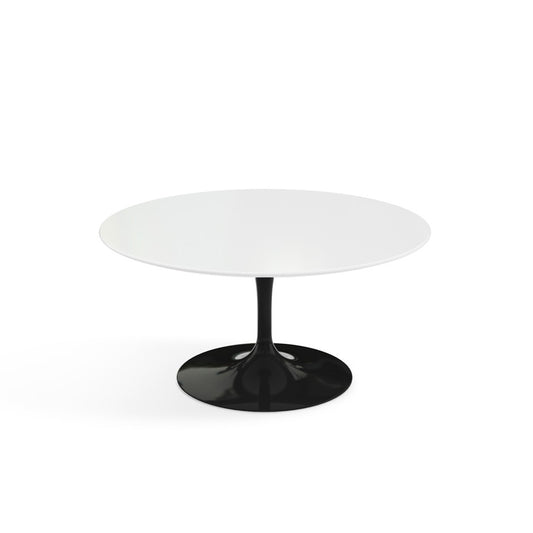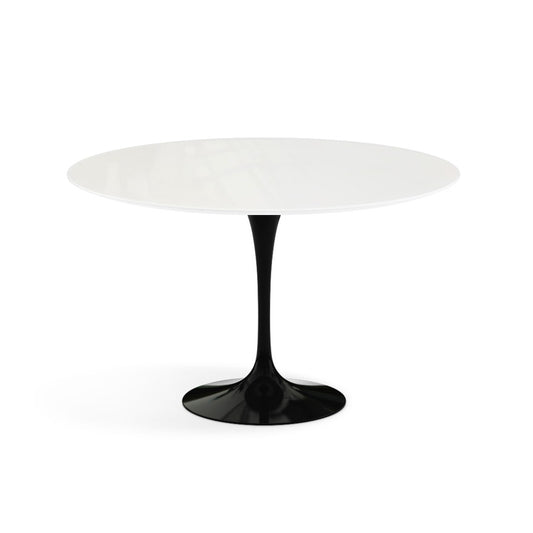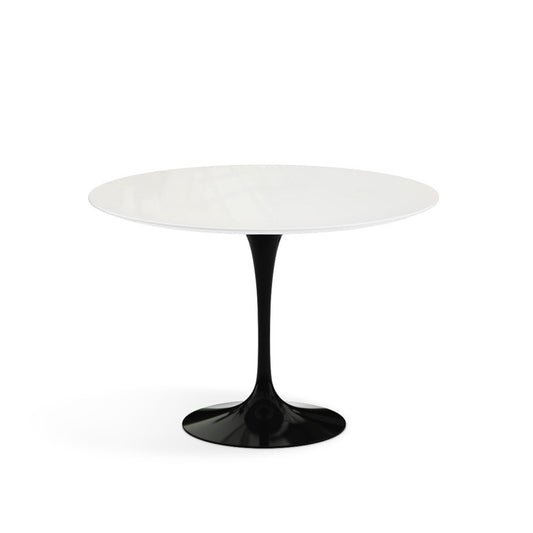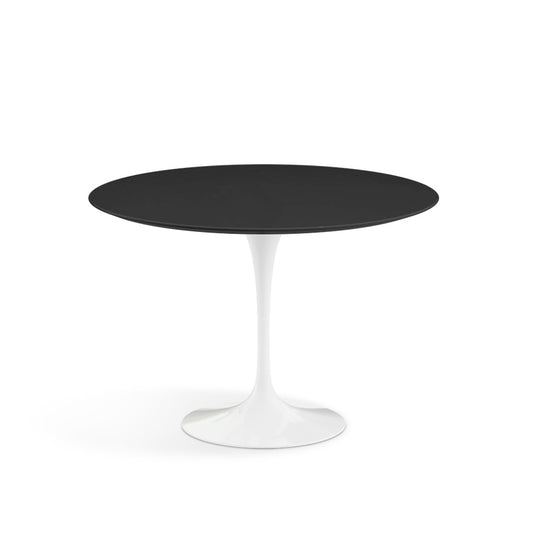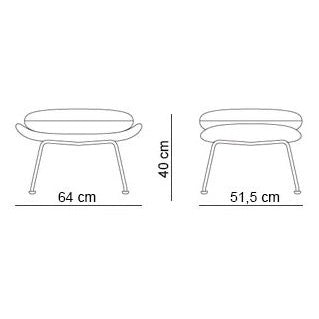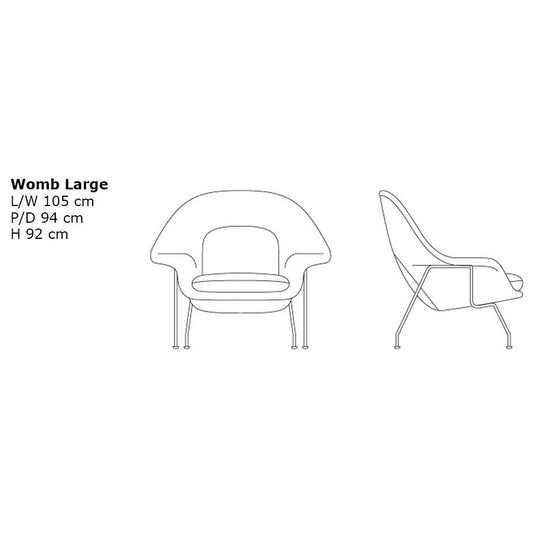컬렉션: Eero Saarinen
Eero Saarinen was one of the most influential 20th-century architects and designers. Born in Kirkkonummi, Finland, in 1910 at the age of 13, he moved to the United States with his father, architect Gottlieb Eliel Saarinen. The young Eero was initially interested in sculpture, probably influenced by his mother, sculptor and fabric designer Loja Gesellius. After attending the Académie de la Grande Chaumière in Paris, he decided to study architecture, graduating from Yale in 1934. He later took specialisation courses at the Cranbrook Academy of Art in Bloomfield Hills, Michigan, where his father was the school's designer and first director. The teaching approach of what was to become one of the most important art and design schools in the United States was based on the Arts and Crafts movement. Cranbrook played a significant role for an entire generation of designers, including Charles and Ray Eames, Florence Shuster Knoll and Harry Bertoia.
Eero's career began in his father's office, with whom he designed the Smithsonian Art Gallery in Washington (1939) and the 25-building General Motors Technical Center in Michigan (1945-1955). After his father died in 1950, Eero continued his career as an architect, producing works characterised by a very personal language, a sort of Mies van der Rohe rationalism mixed with fluid Scandinavian organic forms. The soft lines and sculptural shapes that characterise the TWA terminal at John F. Kennedy International Airport in New York (completed posthumously in 1962) perfectly represent Saarinen's approach. The building was awarded the Gold Medal by the American Institute of Architects.
In parallel with his work as an architect, Saarinen pursued a career as a designer with a similar approach. The sculptural lines and organic shapes that characterise Saarinen's work derive from the synthesis of art and technology, achieved through years of experimentation with materials and production techniques. One example of Saarinen's vision is the Organic Chair, designed with his friend Charles Eames and first prize winner of the design competition organised by MoMa in New York in 1940. The chair was not immediately produced due to technical difficulties but later, the German company Vitra was able to manufacture it. Thanks to his collaboration with Knoll, Saarinen's visionary proposals were mass-produced in the 1950s, leading to the creation of such iconic objects as the Tulip collection (1955), which includes the Tulip Chair and the Tulip Table, and the Womb collection of upholstered armchairs (1948) designed with Florence Knoll. His untimely death in 1961 halted the production of other furnishings created for building interiors he had also designed, including Lounge Seats for the General Motors Technical Center, modular seating for the Law School at the University of Chicago and tables for Vassar College.
-
사리넨 - 라운드 아웃도어 사이드 테이블 Ø51
공급업체:Knoll주문제작 유럽도매가 해상운송 6개월~지금 이 가격은 배송비와 세금이 빠진 금액입니다. 최종 가격은 결제 화면에서 주소지를 입력한 뒤에 확인 가능합니다.정가 ₩1,446,000 KRW정가₩2,991,000 KRW할인가 ₩1,446,000 KRW할인 -
사리넨 - 라운드 아웃도어 커피 테이블 Ø91
공급업체:Knoll주문제작 유럽도매가 해상운송 6개월~지금 이 가격은 배송비와 세금이 빠진 금액입니다. 최종 가격은 결제 화면에서 주소지를 입력한 뒤에 확인 가능합니다.정가 ₩3,202,000 KRW정가₩6,624,000 KRW할인가 ₩3,202,000 KRW할인 -
사리넨 - 라운드 아웃도어 다이닝 테이블 Ø120
공급업체:Knoll주문제작 유럽도매가 해상운송 6개월~지금 이 가격은 배송비와 세금이 빠진 금액입니다. 최종 가격은 결제 화면에서 주소지를 입력한 뒤에 확인 가능합니다.정가 ₩5,120,000 KRW정가₩10,594,000 KRW할인가 ₩5,120,000 KRW할인 -
사리넨 - 라운드 아웃도어 다이닝 테이블 Ø107
공급업체:Knoll주문제작 유럽도매가 해상운송 6개월~지금 이 가격은 배송비와 세금이 빠진 금액입니다. 최종 가격은 결제 화면에서 주소지를 입력한 뒤에 확인 가능합니다.정가 ₩4,634,000 KRW정가₩9,587,000 KRW할인가 ₩4,634,000 KRW할인 -
사리넨 - 타원형 아웃도어 다이닝 테이블 198x121
공급업체:Knoll주문제작 유럽도매가 해상운송 6개월~지금 이 가격은 배송비와 세금이 빠진 금액입니다. 최종 가격은 결제 화면에서 주소지를 입력한 뒤에 확인 가능합니다.정가 ₩9,288,000 KRW정가₩18,672,000 KRW할인가 ₩9,288,000 KRW할인 -
사리넨 - 라운드 다이닝 테이블 Ø152
공급업체:Knoll주문제작 유럽도매가 해상운송 6개월~지금 이 가격은 배송비와 세금이 빠진 금액입니다. 최종 가격은 결제 화면에서 주소지를 입력한 뒤에 확인 가능합니다.정가 ₩9,424,000 KRW에서정가₩18,895,000 KRW할인가 ₩9,424,000 KRW에서할인 -
사리넨 - 라운드 다이닝 테이블 Ø107
공급업체:Knoll주문제작 유럽도매가 해상운송 6개월~지금 이 가격은 배송비와 세금이 빠진 금액입니다. 최종 가격은 결제 화면에서 주소지를 입력한 뒤에 확인 가능합니다.정가 ₩3,121,000 KRW에서정가₩6,457,000 KRW할인가 ₩3,121,000 KRW에서할인 -
사리넨 컨퍼런스 체어 릴렉스 - 스위블 오피스 체어 위드 castors 위드 5-스포크 베이스 (견적문의)
공급업체:Knoll주문제작 유럽도매가 해상운송 6개월~지금 이 가격은 배송비와 세금이 빠진 금액입니다. 최종 가격은 결제 화면에서 주소지를 입력한 뒤에 확인 가능합니다.가격문의 -
사리넨 컨퍼런스 체어 릴렉스 - 스위블 오피스 체어 위드 암레스트 위드 5-스포크 베이스 (견적문의)
공급업체:Knoll주문제작 유럽도매가 해상운송 6개월~지금 이 가격은 배송비와 세금이 빠진 금액입니다. 최종 가격은 결제 화면에서 주소지를 입력한 뒤에 확인 가능합니다.가격문의 -
Saarinen Tulip Armchair Fully upholstered Fabric 사리넨 튤립 암체어 - 풀리 업홀스터드 패브릭 암체어
공급업체:Knoll주문제작 유럽도매가 해상운송 6개월~지금 이 가격은 배송비와 세금이 빠진 금액입니다. 최종 가격은 결제 화면에서 주소지를 입력한 뒤에 확인 가능합니다.정가 ₩4,053,000 KRW에서정가₩8,385,000 KRW할인가 ₩4,053,000 KRW에서할인 -
튤립 - 풀리 업홀스터드 패브릭 체어
공급업체:Knoll주문제작 유럽도매가 해상운송 6개월~지금 이 가격은 배송비와 세금이 빠진 금액입니다. 최종 가격은 결제 화면에서 주소지를 입력한 뒤에 확인 가능합니다.정가 ₩3,215,000 KRW에서정가₩6,652,000 KRW할인가 ₩3,215,000 KRW에서할인 -
Womb ottoman 움브 오토만 - Fabric version
공급업체:Knoll주문제작 유럽도매가 해상운송 6개월~지금 이 가격은 배송비와 세금이 빠진 금액입니다. 최종 가격은 결제 화면에서 주소지를 입력한 뒤에 확인 가능합니다.정가 ₩1,861,000 KRW에서정가₩3,850,000 KRW할인가 ₩1,861,000 KRW에서할인 -
움브 체어 미디움 (견적문의)
공급업체:Knoll주문제작 유럽도매가 해상운송 6개월~지금 이 가격은 배송비와 세금이 빠진 금액입니다. 최종 가격은 결제 화면에서 주소지를 입력한 뒤에 확인 가능합니다.가격문의 -
Womb chair 움브 체어
공급업체:Knoll주문제작 유럽도매가 해상운송 6개월~지금 이 가격은 배송비와 세금이 빠진 금액입니다. 최종 가격은 결제 화면에서 주소지를 입력한 뒤에 확인 가능합니다.정가 ₩4,962,000 KRW에서정가₩10,267,000 KRW할인가 ₩4,962,000 KRW에서할인




